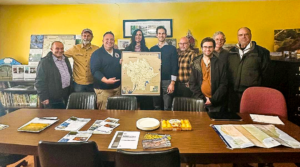September Water Quality Monitoring Results
August Water Quality Monitoring Results
July Water Quality Monitoring Results
June Water Quality Monitoring Results
May TRWA Water Quality Monitoring Data Available
April 2025 TRWA Water Quality Monitoring Results Available
Congressman Jake Auchincloss Visits TRWA

On Thursday February 20, Congressman Jake Auchincloss, Massachusetts’s 4th Congressional District visited the Watershed Center at Sweets Knoll State Park to learn more about what the Taunton River Stewardship Council (TRSC) and the Taunton River Watershed Alliance (TRWA) are doing to continue making strides in challenging times for the environment and environmental organizations.
Congressman Auchincloss was accompanied by state and local leaders interested in our work protecting the environment of southeastern Massachusetts including: From left to right in photo, Tom Ferry, Dighton Public Works; Bill Napolitano, TRWA and TRSC Board Member; State Representative Justin Thurber, Fifth Bristol District; State Senator Kelly Dooner, 1st Plymouth and Bristol District; Congressman Jake Auchincloss; Joe Callahan, TRWA president and TRSC Board; Zachary Caron, Dighton Zoning Board of Appeals; Steve Silva, TRWA Secretary, Water Quality Monitoring and Advocacy Coordinator; Peter Caron, Dighton Board of Selectmen. Photo taken by Catarina Pereira, Senior District and Constituent Services Representative for Congressman Auchincloss.
Joe Callahan TRWA President welcomed the group to the Watershed Center, and briefly described the work of TRWA’s Bruce Spooner Education Center, water quality monitoring and diamondback terrapin population monitoring and protection effort and advocacy programs. Joe described our annual sponsorship of the Taunton River Festival at Riverfront Park scheduled for Sunday, June 8th this year. We encouraged folks to attend. Joe described how we work closely with the TRSC and National Park Service Wild & Scenic Rivers program.
Congressman Jake Auchincloss said that despite the problems in Washington, the Congressman pledged to fight for the environment and support the Wild & Scenic Rivers program and their important work as he has done in the past. He recognizes the excellent and essential work the Environmental Protection Agency (EPA) and organizations like TRWA have done to improve the environment and the quality of life for Americans. He will do all he can to preserve the EPA and to protect the environment from those who would destroy it.
Bill Napolitano described how the TRSC is managed in partnership with the communities bordering the Taunton River. He gave examples of how small grants to communities and nonprofits by TRSC leveraged large amounts of money to remove obsolete dams, purchase land for conservation and promote many other beneficial projects in the watershed. Bill mentioned to those convened the outstanding support that we’d received over the years from Reps. Doherty, Haddad, and Orrall, as well as Sens. Pacheco and Rodrigues, and that both Thurber and Dooner now had an opportunity to be a part of that supportive community. We also spoke of the great support from Barney Frank, Joe Kennedy, Jim McGovern, Ted Kennedy, John Kerry, Joe Maokley, and others, as well as our colleagues at the National Park Service.
Steve Silva described our 30 dedicated water quality sampling volunteers who sample 20 locations in the watershed monthly from April through October. Both Steve and Bill spoke about the great improvement in Taunton River water quality brought about by EPA and the Clean Water Act working in conjunction with river advocates like TRWA. The river has gone from a toxic dangerous eyesore to a community asset supporting recreation, fish and wildlife.
Steve mentioned that he saw similar river and harbor success stories throughout New England during his 40 years managing water programs for EPA New England before retiring and joining TRWA. As an example, he mentioned Boston Harbor infamously known as the dirtiest harbor in the nation in the early 1970s, remember the “Love That Dirty Water” song by the Standells in 1966. Boston now has the cleanest urban harbor in the country acting as a major economic and tourism driver with eel grass and scallop beds growing in the waters adjacent to Logan Airport. Also mentioned was the improvement in Mount Hope Bay’s ecological health and productivity following 10 years of litigation by EPA against Dominion Power with TRWA support to require the company to reduce water discharge heat levels.
We can’t rest on our laurels, however, as polluted stormwater runoff from urbanization, and global warming intensified rainfall and drought along with rising sea level present new challenges.
We thank all of our visitors for joining us.
Staying in touch with your elected officials to keep track of what bills they are supporting, let them know about your concerns or thank them for their environmental support is very important in these times.
For your state legislators go here:
https://malegislature.gov/Search/FindMyLegislator
The members of the state Joint Committee on Environment and Natural Resources:
https://malegislature.gov/Committees/Detail/J21
This will give you a list of federal, state and local officials and contact information if you provide you complete location information:
